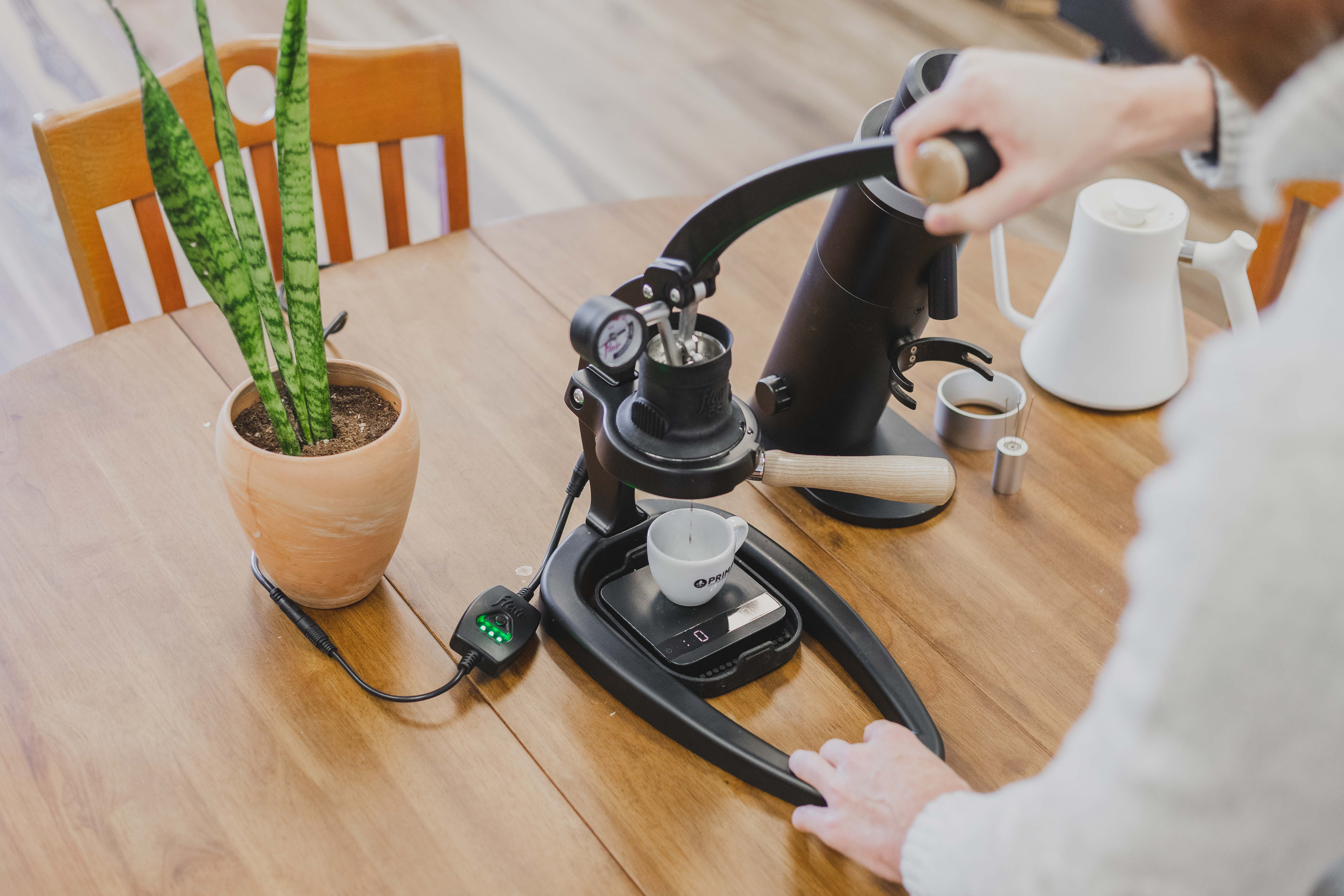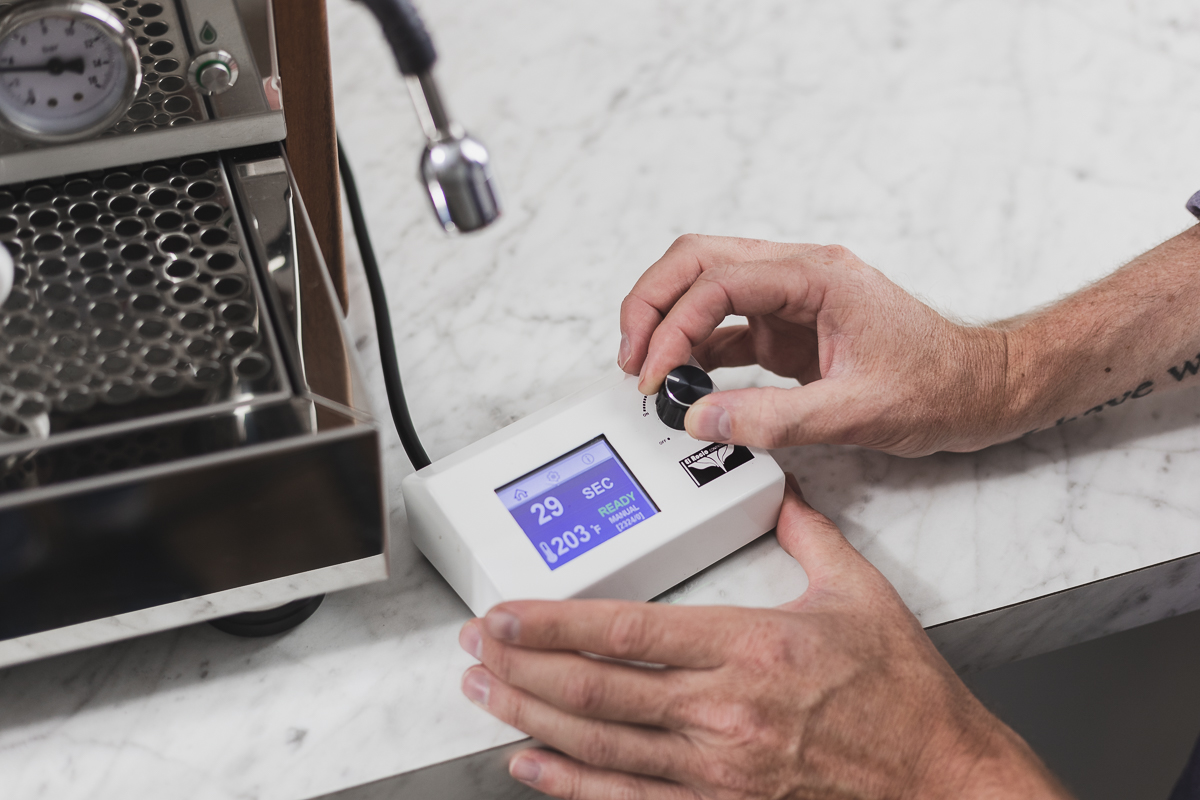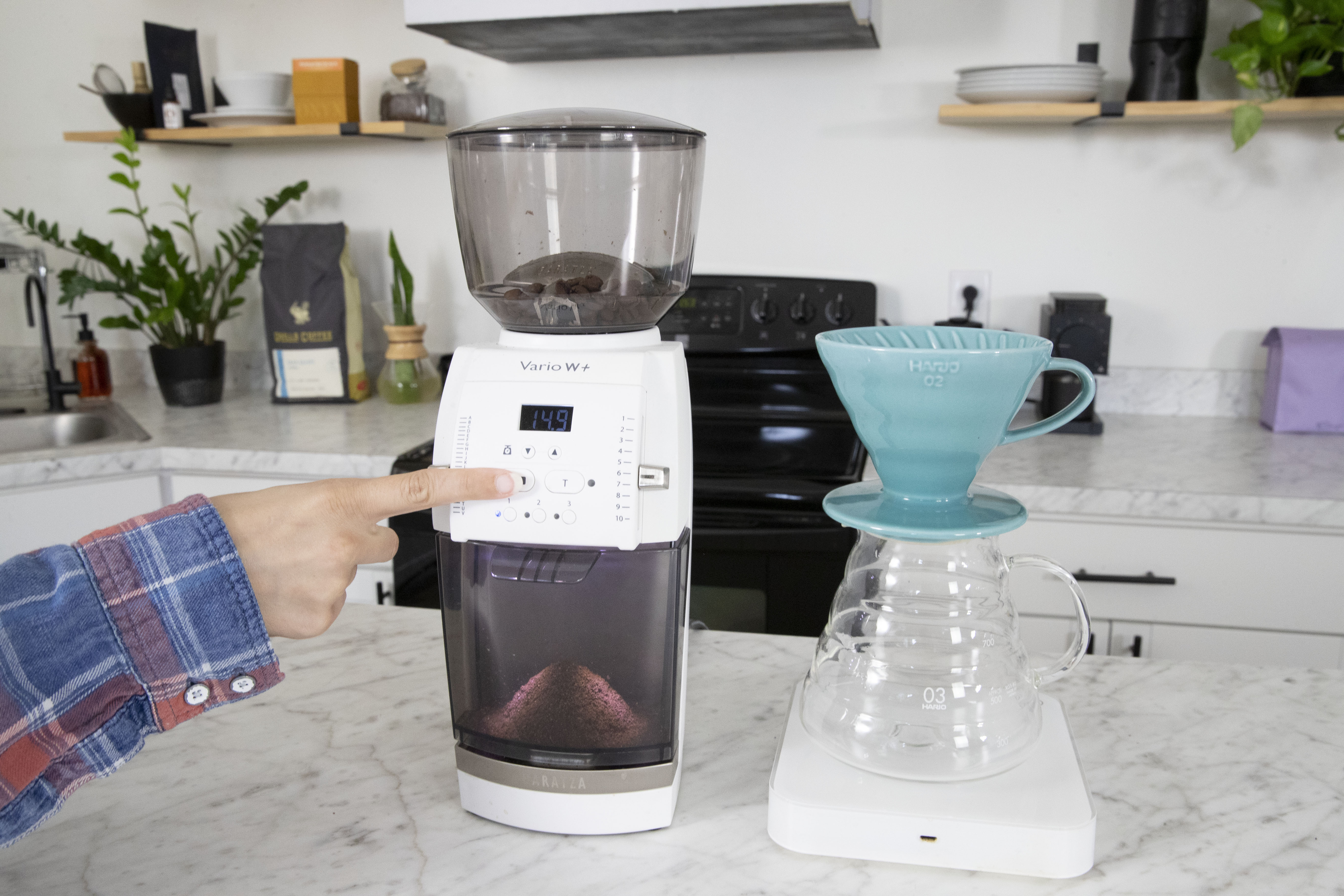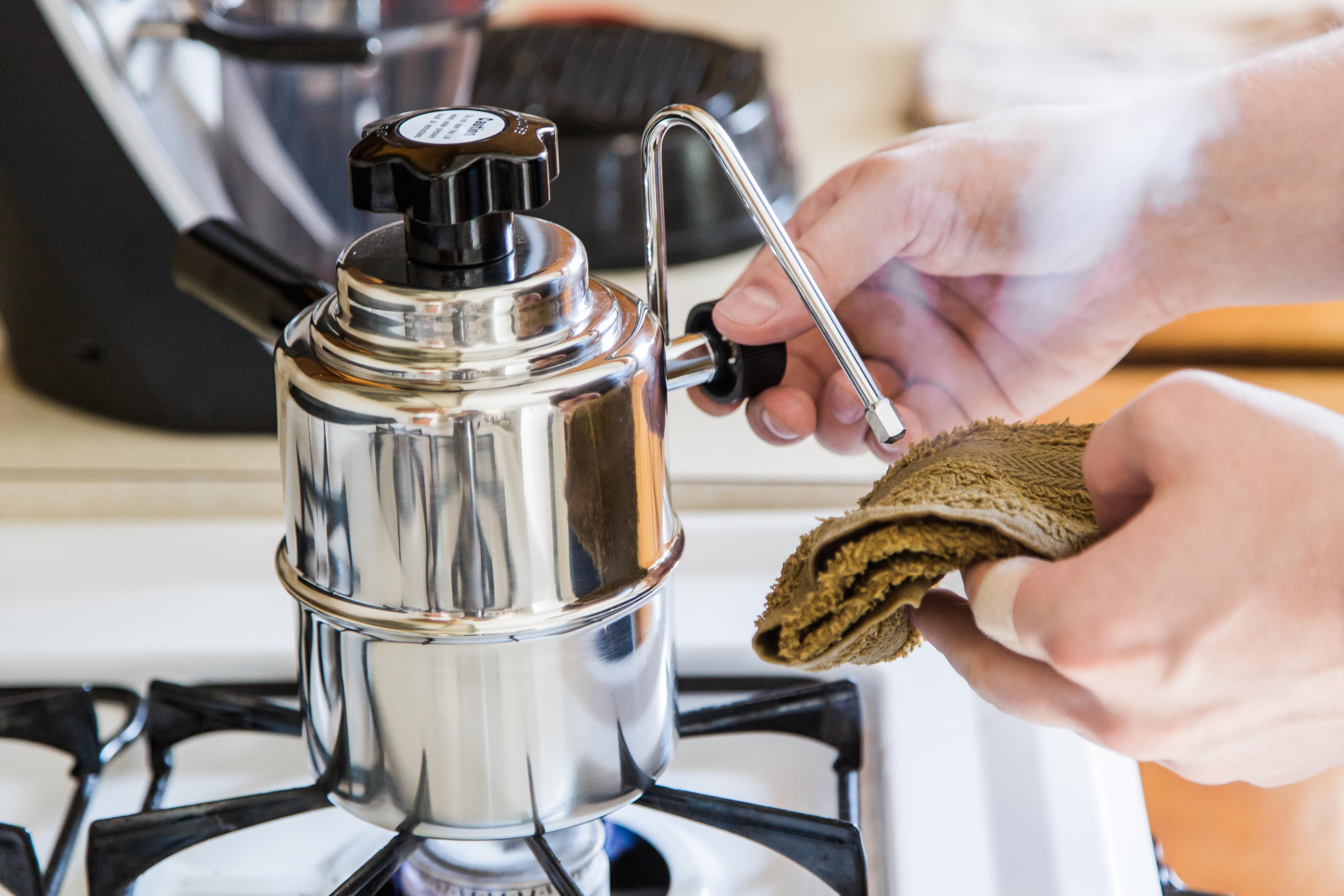Espresso 101: How Do I Get Started With Espresso?
Get started in the alluring world of home espresso with this helpful guide—full of tips for exploring what equipment to buy, how to set a budget, and where you can go beyond beginner gear.
As you watch your barista meticulously grind coffee into a basket and carefully tamp it down, steam milk to just the right temperature, and pour a beautifully intricate rosetta into your cup, a wisp of a thought enters your brain: how can I do what she just did back at home?
For coffee enthusiasts, home espresso is one of the most captivating subjects out there. It’s perhaps the most distinctive white whale we have, offering almost limitless room to improve the craft, fine tune the results in the cup, and unearth even more insight into the elusive art and science of making the perfect little shot of coffee. But a good part of the intrigue is that home espresso equipment can quickly become expensive, and it requires more attention and maintenance than other brewing methods, so for many hobbyists in coffee it is simply not as accessible as something like a humble french press.
It’s true that espresso equipment tends to be expensive, and even then you aren’t guaranteed cafe-quality results. With time and practice many espresso makers are capable of great coffee, but some devices will make that learning process quicker and easier than others, and often that comes with a considerable hike in expenses. But, no need to fear, if your heart is set on making espresso at home - whether it’s to cut down the costs of enjoying a latte each morning or to master the art of brewing coffee under high pressure - we have some great tips to help get you started and on your way to becoming a better barista at home.
Below, you’ll find tips for navigating the world of espresso equipment, setting your budget and your expectations, as well as links to further resources for learning how to pull a great shot and steam milk like the pros.
Understanding Espresso Machines
Every espresso machine today has a few essential features in common - namely, they all force hot water through a finely ground bed of coffee (called a "puck") under high pressure. That combination of factors allows the coffee to extract quite quickly, usually in around 30 seconds, to create an intensely flavored shot of strong coffee with a distinctive head called crema.
Espresso machines brew coffee by using a filter basket filled most of the way with finely ground coffee, which is inserted into a holder called a portafilter. The grind fineness is often essential to the brewing process, as it provides the resistance to the flow of water and thus assists in creating brewing pressure. If the coffee is too coarse, there won’t be much brewing pressure, and the coffee will taste weak, thin, and a little sour. If it’s too fine, the water will have trouble flowing through the coffee, slowing or "choking" the flow rate, and the coffee might be too intense, too bitter, or in some cases nonexistent because the water wasn’t able to penetrate the puck. Quite often, the fineness of grind and how much coffee is added to the basket is entirely up to the user. Some machines are capable of grinding and dosing on their own without direct user input, though some programming may be available to make adjustments.
How the espresso machine goes about making hot water or producing pressure will vary, and sometimes it doesn’t actually produce anything on its own, it just provides the user with the means to do so (but more on that below). The espresso machine in your favorite cafe very likely has internal boilers, which heat water to the desired temperature, and dispenses it with a pump capable of hitting and sustaining around 9 bars of pressure (around 130 psi). In the earlier days of espresso, machines used manual lever-action pistons to provide the pressure, and the machine itself mainly made the water hot. Machines of both sorts exist today, and both are equally able to make great coffee when put in capable hands.
Espresso machines fall into a few different classes:
Manual espresso machines require the user to initiate and stop the brewing process themselves. They do not possess an electric pump, and may instead use a lever actuated piston or some other means of manually applying pressure. Some manual machines are completely unpowered, so an external source of hot water must be used.
Semi-automatic espresso machines use an electric pump to provide the brew pressure, and they also heat the water in a boiler or thermoblock. The user will start and stop the brewing process themself, but the pump does all the actual work of brewing. The user does still grind and tamp the coffee into a basket themself.
Automatic espresso machines are essentially semi-auto machines with extra programming to start and stop the brewing process. This may be done by time (e.g. brewing for a total of 30 seconds), by volume (e.g. dispensing a total of 75 mL of water), or in some cases by mass (e.g. brewing until the scale reads 55 grams). Most automatic machines can still be run semi-automatically, with the user starting and stopping the brewing process on their own. The user also must still dose, grind, and tamp themselves.
Superautomatic espresso machines are do-it-all devices which dose, grind, tamp, brew, and even self-clean after brewing. Many are programmable to the user’s desired specifications such as brewing temperature, dose size, and beverage volume. Some can even self-adjust as the coffee ages and performs slightly differently. The user needs only to select the drink they want, and the machine programming will take care of the rest. Some superautos also include functions for frothing and adding milk, so one push of a button can yield a cappuccino in just a few minutes.
Generally speaking, the more that a machine does for you, the more expensive it will be. Simple manual espresso makers can be rather affordable, but they may also be frustrating to use because they can produce inconsistent results without adequate care in preparation. While other machines may be very expensive in comparison, using them may be a much simpler process because they include temperature control, higher quality parts, or other features which make them more reliable and produce more consistent coffee quality.
Don’t Forget the Grinder!
There’s one piece of advice that is often offered to people shopping for espresso equipment, and it can’t be overstated: do not underestimate the importance of the grinder! It is an essential component of making espresso at home, and it may even be worth spending more on the grinder than any other piece of equipment. Need help deciding what grinder is right for you? Check out our blog to determine which one is best for you!
As I’ve mentioned above, grind size is critical to producing good shots of espresso. In part that’s because brewing pressure is reliant on the ground coffee to create resistance to the flow of water. Every coffee will be a little different, even two bags of the same blend, so having your own grinder on hand is the best way to make the fine tweaks that are needed to adjust your shots and make sure they’re always tasting great.
Not every grinder is up to the task of making espresso, but you don’t need to take out a loan to afford one. A good espresso grinder needs to be able to grind fine, of course, but ideally it can also make small adjustments to the fineness. Because espresso is brewing under such extreme pressure, a very small change in grind size can noticeably change the flavor of the shot. So we often recommend looking for "stepless" grinders, grinders whose adjustment mechanism has no click or stops or settings, but instead is smooth and continuous between fine and coarse. If a grinder has steps but they correlate to very small changes in grind size, it might still be adequate for espresso use. Baratza’s Vario grinder, for example, has stepped settings for both its macro and micro adjustment scales, and it performs superbly as an espresso grinder.
If you’re interested in learning more about burr grinders, we have another great resource on the subject covering everything from top to bottom—and it even pays special attention to picking out an espresso grinder.
Deciding On a Budget
Now, even though espresso can get expensive, it’s possible to find equipment that fits a variety of budgets. Again, some of the least expensive gear out there can be somewhat rudimentary and a little harder to work with, but we have ample recommendations that will still make a fantastic shot even if they need a little extra coaxing.
Want to know what a common starting budget looks like? Well, for beginner level equipment with somewhat reliable products and build quality, you’d plan to spend around $1,000. That number might be a little tough to stomach, so here’s a list of what that would get you (*prices as of August 2022; check listings for most up-to-date prices):
- Beginner espresso machine: Rancilio Silvia: $830
- Espresso-capable hand grinder: 1zpresso J-Max $230
- An espresso tamper: Starting at $50
- A tamping mat to protect your counter: $8.99
- A basic steaming pitcher for milk drinks : Starting at $18
- A bag of beans to get started: $20-30
- A scale for measuring dose and yield: $35
- A few cups for espresso and milk drinks: $20-40
That $1,000 includes some other wares but clearly the bulk of it will be spent on the two big ticket items: the machine and the grinder. The grinder in question is a compact hand grinder that works quite well for espresso. It can be a little tiring trying to grind multiple doses on such a fine setting by hand, but the flip side is that the grind quality is superb for the money. The machine is well built and has a great reputation, but it is a basic unit without much in the way of extra features. It heats water for brewing, it has a steam mode, and it has an electric pump to brew your coffee. The commercial quality components inside mean it’s built to last, and parts and service are easier to come by than some cheaper machines. The smallwares and accessories included aren't all essential - you definitely need a tamper, but you could use a kitchen towel instead of a tamping mat - but are included because they're basic accessories for a typical espresso setup. Other items you may with to consider include a knockbox for disposing of used pucks, microfiber rags for cleaning and drying your tools, a thermometer for steaming to your desired temperature, and a digital shot timer if your machine doesn't have one built in, plus some cleaning supplies.
Can you spend less than this? Absolutely. Here’s an example of a more barebones but budget-minded setup:
- Flair manual espresso machine: $325
- Timemore Slim Plus hand grinder: $145
- A small scale for measuring doses: $35
- A demitasse for your shots: $8.80
- A small kettle for heating water: $45
- A bag of beans: $20-30
We’ve cut the budget by more than half with this equipment, at the expense of quite a few features. The Flair espresso maker is a manual device with a lever operated piston. It’s designed to break down for travel, and stores in a compact padded case. While it's capable of good espresso, it doesn’t have a pump or a heat source for water, so you must provide that yourself, and it also isn’t capable of steaming milk. Brewing temperature will be a larger concern with this machine, so you need to thoroughly preheat the chamber and basket prior to getting started.
Extremely Low Budget Espresso
Some of you might still be wondering: can we take the budget down even lower? Yes, perhaps, but we’ll have to make some tweaks. For one, we’ll have to start considering used equipment. Used gear might not always be in good shape, but workable machines can be found in local classifieds or on online auction sites in many areas. They may need some cleaning and TLC, but occasionally you’ll find a very good deal on an otherwise expensive starter machine.
Another possible approach is to carefully consider inexpensive machine brands online or in departments stores. "Carefully" being the operative word here because the low price points can obscure a lot of the potential risks of buying a machine like this. If you desire cafe-quality results, you’ll want to stick to machines which feature a pump and do not use a pressurized portafilter or basket. A pressurized portafilter, or PPF, is like a standard portafilter with the addition of a mushroom valve or some other means of creating back pressure in the brewing system. This de-emphasizes the need for correctly ground or fresh coffee, and simulates crema by frothing and aerating the liquid to create a foam. Some of these systems are designed to be dismantled in the event that the user wants to use a standard single-wall filter basket, while others must be permanently altered or destroyed in order to de-pressurize them.
Regarding the risks of low-priced machines, most are directly associated with the corners that need to be cut to drive the price down. There will be a lot of plastic parts, less precise manufacturing, a lack of replacement parts or outright prohibition of the user to perform service or repairs. Many such machines are essentially "disposable," not designed to be long-lasting and repairable, and tend not to carry a strong backing by the manufacturer. That said, these machines also don’t necessarily fail more often in their lifetimes and can be enjoyed for years before perhaps you just decide to upgrade. I got my own start in home espresso with such a machine, a Hamilton Beach model which cost around $80 at the time. It survived nearly four years before scale buildup started causing leaks, and I was unable to properly repair the damage due to how the machine was assembled.
Alternative Brewing Devices
Let’s say you’re not committed to espresso exactly, but want to somehow approximate your favorite latte at home. While espresso is a fairly unique brewing process and beverage, sometimes just making a strong coffee will suffice. For that, we have plenty of options today. The AeroPress, for one, is a longstanding favorite brewing device of ours, and originally it was designed to create a strong shot of coffee for one person. Intrepid users have come up with all sorts of ways to produce coffee using the AeroPress that is more similar to espresso, from doubling up on filters to creating specialized brewing caps for the device. With a strongly brewed coffee as the base, you can quickly and easily make a decent faux latte at home - and best of all, the AeroPress comes in just under $40.
The classic way to approximate espresso at home is through the use of a stovetop moka pot. In its earliest form, Italian espresso was brewed in a very similar manner, using only steam pressure to force hot water through coffee grounds, and as such the moka pot has long been considered to be an "espresso maker." Compared to today’s espresso, it’s quite weak and under-strength, but moka pot coffee is still good in its own right, and tastes stronger than your average mug of drip. It can even form a little bit of crema if brewed correctly, though I wouldn’t expect a rich layer of the stuff to grace your cup.
If you’re looking for a way to make steamed milk at home, look no further than the Bellman stovetop steamer. It’s a simple device, consisting of a boiler with a steam wand and valve, and it only takes about 10-15 minutes to fully heat up and steam enough milk for a cappuccino or latte. It’s not quite as powerful as a commercial machine, but it is plenty capable of making microfoam so you can practice your latte art in your own kitchen. Other simple devices like battery operated milk whisks, or even a standard french press, can froth hot milk to a similar consistency and won’t break the bank.
The Upgrade Path
Many home espresso enthusiasts find themselves wanting to upgrade their equipment at some point. As a brewing method, espresso can be quite finicky and demanding of the user and the machinery, so often this results in "upgradeitis." The urge to step up to fancier gear tends to creep in after a few years of ownership, so it’s certainly helpful to know what’s out there and what potential benefits there are to gain. Generally speaking, espresso machines will show distinct performance and features gains up to around $1500-2000, and from there the upgrade advantages might be more minimal, or focused more on user experience than beverage quality. In espresso grinders, while a $300-500 home grinder might be considered sufficient, many commercial grinders will still offer superior grind quality and flavor in the cup beyond $3000 or so.
Most starting machines are single boiler or thermoblock machines with limited water heating capacity and almost no temperature control. This affects your espresso every day, and even shot to shot, so you may experience consistency issues. Upgraded machines will have larger boilers, digital temperature controllers, and improved consistency. They may also add simple pre-infusion, a lower pressure setting which introduces some water into the coffee puck before ramping up the pressure, often resulting in better extractions and tastier shots.
Beyond single boiler machines, there are heat exchanger and dual boiler machines. Enthusiasts may scuffle over which is best or most preferred, but in reality both have their strong suits and make perfectly good espresso. Heat exchanger machines use one large steam boiler as the main means of heat generation, and the brewing water is heated indirectly as it runs through a tube or coil inside the steam boiler. This can cause some temperature inconsistency because water that has sat in the heat exchanger for a long time will be hotter than water that flowed through it quickly, but most HX machines have fairly predictable temperature patterns that can be learned with use. Dual boiler machines have separate boilers for brewing and steaming, and quite often have digital temperature controllers for each. They are also more expensive, because of the extra material and technology, but as you might imagine they tend to function with good consistency and precision.
For espresso grinders, much of the upgrade path will see improvements in construction materials (e.g. less plastic and more metal), internal stability, dosing consistency and precision (e.g. reliably dosing precisely 18.5 grams as programmed), as well as burr cutting patterns that improve flavor quality. Many lower end espresso grinders will use conical steel burrs. Moving up, you’ll see a mix of conical burrs and flat burrs, until the highest end grinders which primarily use flat burrs. As far as the espresso is concerned, flat vs conical doesn’t matter too much, but there are some flavor differences to be found between the two, and today’s flat burrs seem to be better at creating very uniform particles than conical burrs are.
Essential Maintenance
As mentioned previously, espresso equipment requires more maintenance than many other brewing methods, and as such it can be somewhat off-putting. Espresso machines are powerful devices, but they can succumb to grime buildup without proper care. Similarly, espresso grinders need routine attention to make sure they aren’t put under undue stress, which can cause premature wear or failure.
Typical maintenance procedures for espresso machines include regular cleaning of the group head, including the screen and gasket, cleaning of the portafilter and basket, and possibly backflushing the brew path with detergent (not required by all machines, only those with a three-way solenoid valve). This ensures that the brew path and anything that comes into contact with coffee or water stays free of buildup and rancid oils, which can not only cause off-flavors in your coffee, but also can cause blockage and damage the machine.
Water quality is of the utmost importance when making espresso, as scale buildup can quickly lead to the death of your machine. Scale is created when minerals dissolved in the water deposit inside the boiler or internal tubing, restricting the flow of water or blocking it off entirely. Scale can sometimes cause valves to stick open, leading to destructive leaks - or it can cause seal failures as pressure builds up, leading to dangerous conditions where boilers can burst and spray hot water and steam. Ideally, the water used for espresso machines has low scale-forming potential. It should have low calcium and magnesium content, and low carbonate hardness.
Since water that is too "pure" is not considered good for coffee brewing, the alternative to filling a machine with distilled water is to use filtered or softened water, and to occasionally descale the machine using a weak acid solution or a commercial descaling product. This will ensure a long and healthy life for your machine.
Grinders tend to be simpler to maintain: they primarily need to be cleaned out periodically with a brush, vacuum, or a grinder cleaning product like Grindz. Our post on grinder maintenance is full of helpful tips for cleaning out your grinder, and we recommend a light cleaning once a month with regular use.
Learning Resources
There’s a whole lot more to cover concerning espresso and equipment, so if you’re eager to take it all in we have some great places to start. Be sure to check out the learning center, where you’ll find instructions and videos for how to make espresso, how to select equipment, and how to maintain your gear for a long and happy life.











